30 Most Common Types of Butterflies in Massachusetts (With Pictures)
-
Pete Ortiz
- Last updated:

An encounter with a butterfly is always a special one. Their variety of colors leaves you in awe and wanting to know more as they flutter away.
Almost every Northeastern butterfly species in North America can be found in Massachusetts, whether it’s a permanent or temporary home. Hundreds of butterflies can be found in the small state of Massachusetts, but in this article, we discuss just some of the most common species you can encounter.
The 30 Common Types of Butterflies in Massachusetts
1. Monarch Butterfly
| Scientific name: | Danaus plexippus |
| Identifying Characteristics: | Orange and black |
Monarch butterflies are the most common in Massachusetts. The Monarch migration is one of nature’s most amazing phenomena. On the East Coast and in states such as Massachusetts, they migrate annually to Florida or Mexico. They know precisely where to migrate, even if they have never relocated before.
A single Monarch can travel hundreds or even thousands of miles, using its internal compass to guide it in the right direction. They have two sets of wings spanning up to 3–4 inches and are identified by a magnificent bright orange. They have black borders and black veins with small white spots around the edges.
2. Red Admiral

| Scientific name: | Vanessa atlanta |
| Identifying Characteristics: | Dark brown/black wings with red band and white spots |
Red admirals are very common in Massachusetts and are easy to find. They will often land on humans and are usually very calm and easy to approach. The Red admiral is a migratory butterfly that does not spend the winter in the state.
Its numbers vary in any given year, ranging from uncommon to abundant across the state. Red Admirals are active almost continuously from May to October, with three distinct peaks: May, July, and late August to early September
3. Painted Lady
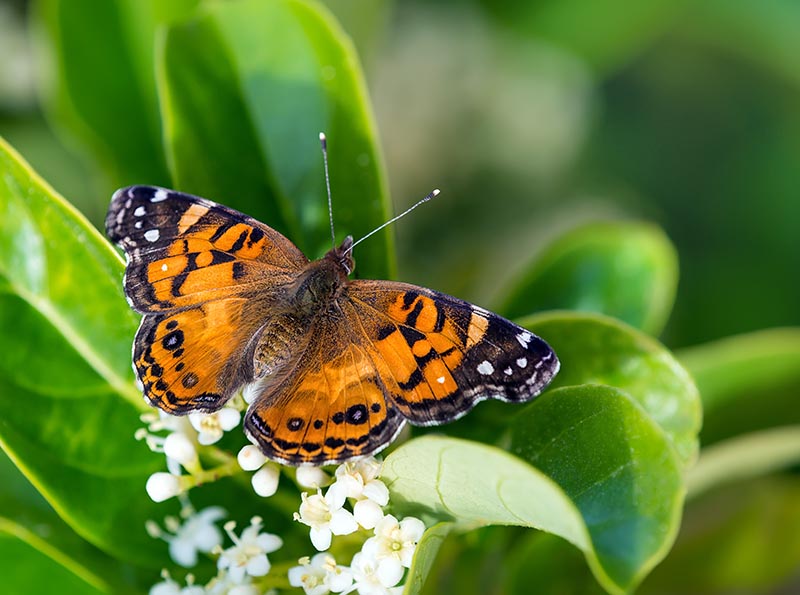
| Scientific name: | Vanessa cardui |
| Identifying Characteristics: | Orange/pink wings edged with black markings and white spots |
In Massachusetts, Painted Lady butterflies can be found fluttering about in open areas that are silent and undisturbed, such as grasslands and gardens. The population of Painted Lady butterflies can vary significantly from year to year and usually go unnoticed for years in some places. Then, they suddenly appear in greater numbers.
They spend the winter in Mexico and return in the spring. Due to its constant migration pattern, it spends its entire adult life in suitable locations for its eggs to hatch, making it the only butterfly that mates all year!
4. Small White

| Scientific name: | Pieris rapae |
| Identifying Characteristics: | White wings with charcoal tips |
The Small White butterfly is abundant and widespread in Massachusetts and is the only one found in the state’s eastern half. Two other Whites are found in western Massachusetts, but the Small White can be differentiated by its charcoal wingtips, and the wings are not marked with dark scales. They are common in gardens and cabbage crops throughout the state, and the adults can be seen sipping colorful flower nectar.
5. American Lady
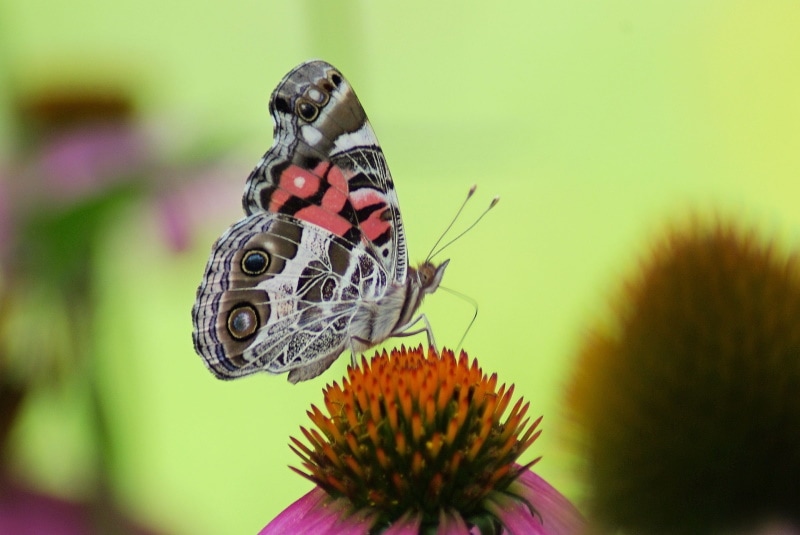
| Scientific name: | Vanessa virginiensis |
| Identifying Characteristics: | Bright orange wings with black borders and white and purple spots. The underside of the wings has weblike markings |
The American Lady migrates its wintering grounds in the Southwest to Massachusetts. Most years, only a small number of butterflies arrive in Massachusetts. Flight dates vary from year to year due to the species’ irregular arrival, but it will fly until the cold weather arrives. American ladies can be spotted in open areas with flowering plants, but they can be timid and will fly away if they are disrupted.
6. Viceroy

| Scientific name: | Limenitis archippus |
| Identifying Characteristics: | Deep orange with black veins and black wing borders with white spots |
The Viceroy can be easily confused with the Monarch as they are almost identical. You can tell them apart by the black line at the bottom of the Viceroy’s wings. Today, the Viceroy is common and noticeable throughout the majority of Massachusetts. They can be found near water sources, particularly on willows throughout the state.
7. Pearl Crescent
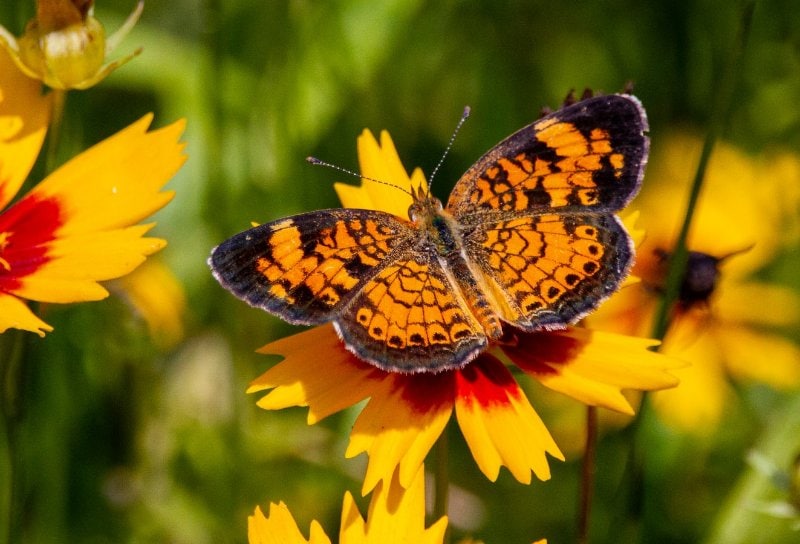
| Scientific name: | Phyciodes tharos |
| Identifying Characteristics: | Bright orange wings with black borders and markings that resemble lace |
The Pearl Crescent is the most common small orange and black butterfly in Massachusetts. They fly continuously from mid-May to early September.
They prefer open, sunny habitats but can be found in various settings. Because of its long season, the Pearl Crescent has been observed eating nectar from a diverse range of flower species.
8. Mourning Cloak
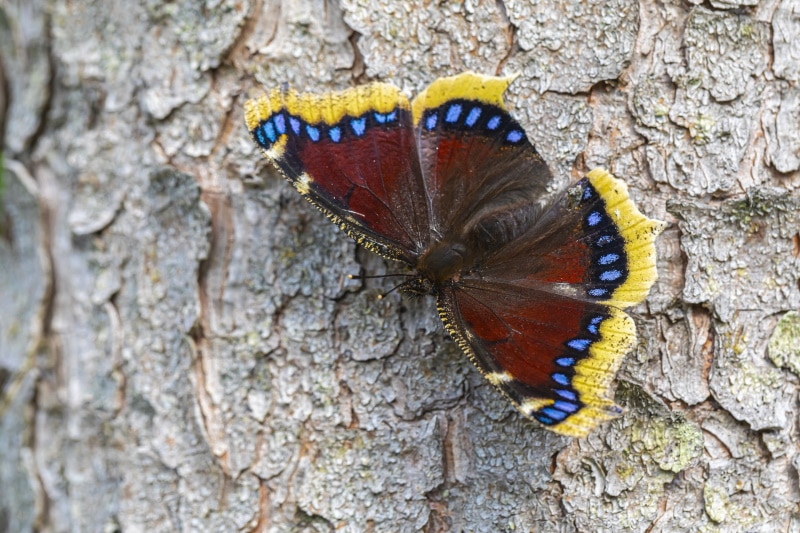
| Scientific name: | Nymphalis Antiopa |
| Identifying Characteristics: | Black wings with a purple border and purple spots beside it |
Despite its widespread distribution, the Mourning Cloak may be challenging to locate in Massachusetts because its preference for cooler temperatures and lone habits makes it difficult to spot. Furthermore, when its wings are folded, it is so well-camouflaged that you might miss one right in front of you.
Mourning Cloaks are frequently the first butterflies to emerge in the spring! Some adults are even active during the winter on warm days when snow is still on the ground. Mourning cloaks can live for more than 10 months, are one of the longest-living butterflies, and have been seen in flight in Massachusetts every month of the year.
9. Question Mark
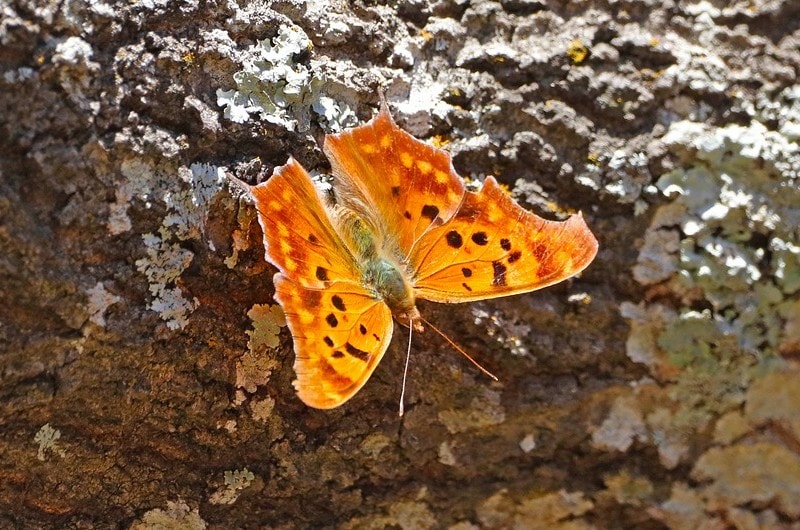
| Scientific name: | Polygonia interrogationis |
| Identifying Characteristics: | Dark orange wings with black spots and a lavender rim. The “question mark” is formed by a silvery, curved bar and a separate dot on the hindwing below |
Their name is derived from a faint, light-colored marking on the underside of the wing; it’s vague, but once you spot it, you can’t unsee the question mark shape. The upper side of their wings is brightly colored, but the lower side is a camouflage coloring that helps the butterflies blend in, making them look like dead leaves resting on a branch.
Throughout much of the state, the Question Mark is relatively common and widespread. Usually, one or two Question Marks can be found in a given location.
10. Eastern Comma
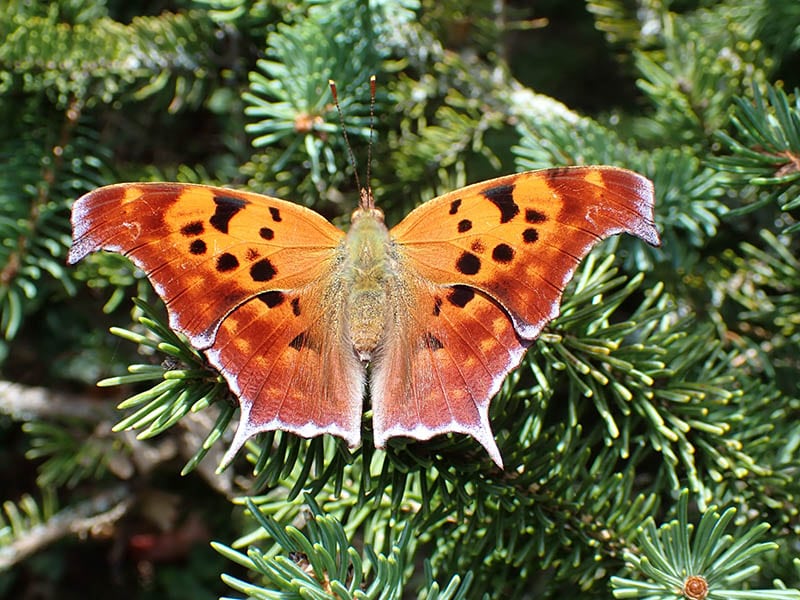
| Scientific name: | Polygonia comma |
| Identifying Characteristics: | The upper wings are orange with black markings, and the lower wings are primarily black with some orange spots |
The Eastern Comma resembles the question mark butterfly, but it can be distinguished by its smaller size, more ragged wing outline, and “comma” on the underside of each hindwing. They’re common in Massachusetts, and your chances of seeing one are good. Eastern Comma butterflies can be found in deciduous woodlands, residential yards, and parks.
11. Red Spotted Purple
| Scientific name: | Limenitis arthemis astyanax |
| Identifying Characteristics: | The wings are iridescent blue-black with rows of orange or red spots around the rim |
Their spectacular iridescent wings with bright red-orange spots not only make them stand out but is also their primary defense against predators. They adapted their coloring to resemble the venomous Pipevine Swallowtail butterfly. This same butterfly is known as the White Admiral in the northern part of its range, where there are no Pipevine Swallowtails.
In Massachusetts, the Red-spotted Purple and White Admiral flight times are very similar. Adults typically fly from mid-June to early August, with a second brood flying from mid-August to mid-September.
12. Common Buckeye

| Scientific name: | Junonia coenia |
| Identifying Characteristics: | Wings are brown with orange bars. Three to four prominent eyespots are outlined in black and white rings with blue, magenta, orange, and green middles |
In Massachusetts, common Buckeyes prefer open spaces such as grasslands and old fields. They fly low to the ground and will sit long enough for you to admire but will flutter off quickly if you try to approach them. The Common Buckeye is a summer and fall visitor only because it cannot survive cold winters and returns almost every year to Massachusetts in varying numbers.
13. Black Swallowtail
| Scientific name: | Papilio polyxenes |
| Identifying Characteristics: | Black with two rows of yellow spots, one row bordering the wings. Hindwings are speckled blue with an orange spot in each |
Black Swallowtails can commonly be spotted in gardens in Massachusetts. Plant lots of nectar-rich flowers in your yard, and these beautiful butterflies will frequently visit for a sip. Black swallowtail butterflies outlive other species in Massachusetts and are distinguished by their beautiful wing shape and colors.
14. Small Copper

| Scientific name: | Lycaena phlaeas |
| Identifying Characteristics: | Upper wings are orange with a gray/brown border, and the lower wings are the same colors but inverted |
Small Coppers are also known as American coppers, Little Coppers, and Common Coppers. The American Copper is one of the most familiar butterflies in the state. During the peak of its flight periods, it can be found in large numbers in almost every area of the state, in a wide range of habitats. American coppers can withstand various weather conditions, from long, cold winters to humid, hot summers.
15. Peck’s Skipper
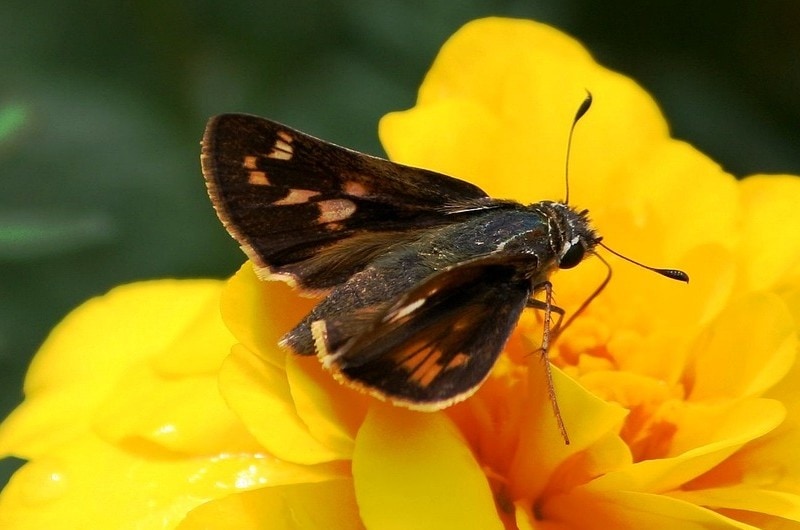
| Scientific name: | Polites peckius |
| Identifying Characteristics: | Wings are brown with red/orange patches. The underside of the hindwing has a patch of yellow spots |
You can spot a Peck’s Skipper butterfly in an open grassy field or meadow. It is one of the state’s more common skipper species. It can be found all over the state during flight periods, sometimes in large numbers. These butterflies are also known for their ability to fold their forewings, distinguishing them from other skipper butterflies in the state.
16. Silver-Spotted Skipper
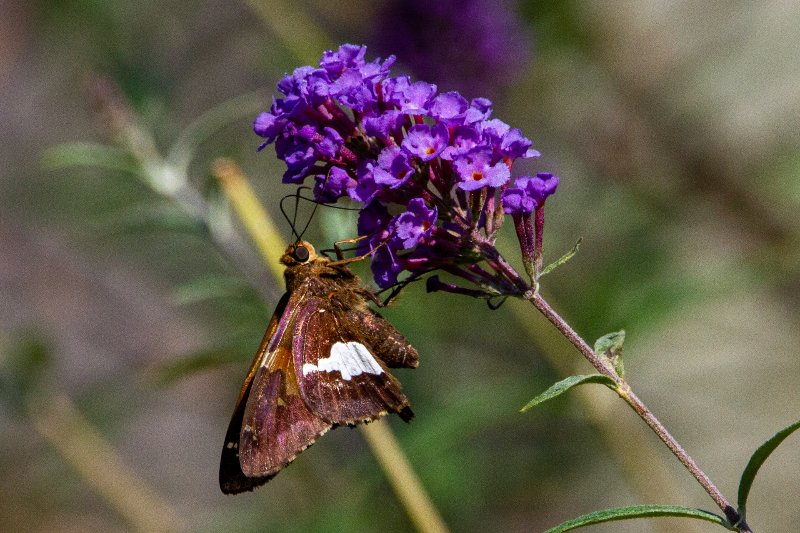
| Scientific name: | Epargyreus clarus |
| Identifying Characteristics: | Wings are long and brown with a band of yellow-orange rectangular spots on the forewings and a distinctive silver-white patch beneath the hindwings |
The silver-spotted Skipper is one of the state’s most common large brown species. It’s common throughout Massachusetts but in small numbers at any location. It visits a wide variety of flowering plants in open parks, fields, and suburban gardens, particularly near locust plants.
17. Zabulon Skipper
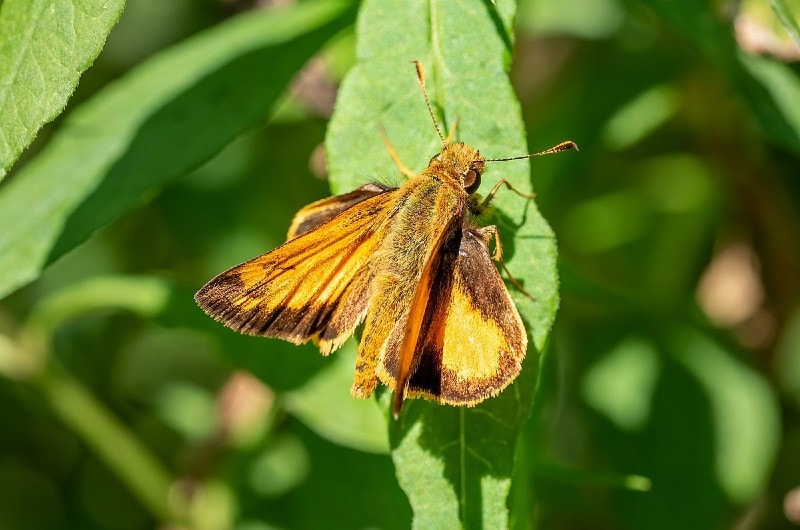
| Scientific name: | Lon zabulon |
| Identifying Characteristics: | Brown and yellow coloring. Dorsal coloring is predominantly brown, whereas ventral coloring is predominantly yellow |
The Zabulon Skipper is a relatively new species to Massachusetts and has been moving north through the state. It was first documented in 1988 and had spread throughout eastern Massachusetts as far north as Essex County by 2012.
Males and females have different coloring. Males have more yellow on their forewings, whereas females have brown. They prefer woodland edges and openings but will happily visit gardens if there is a nearby water source. They are most active in the afternoon when males look for females to mate with.
18. Eastern Tailed-Blue
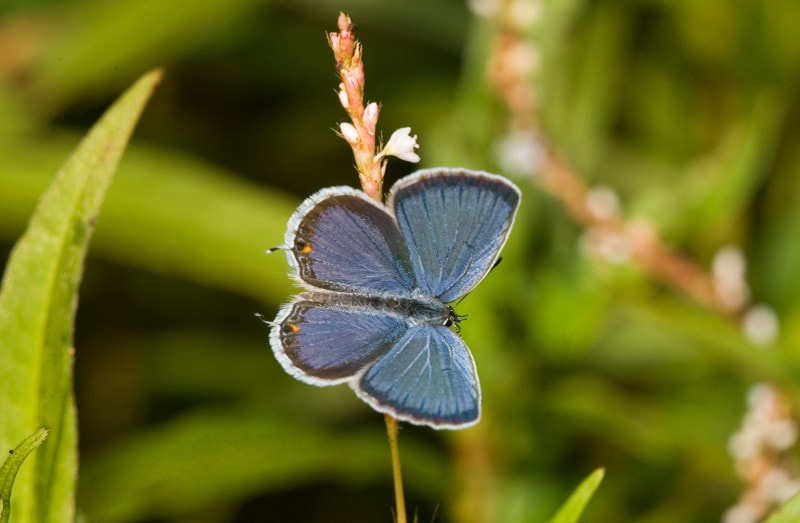
| Scientific name: | Cupido comyntas |
| Identifying Characteristics: | The upper wings of males and females are very different in color. Females are gray/brown with white edges, while males are blue with a brown border. Above the wing tails, both sexes have one or two small orange spots |
Eastern Tailed-blues are one of the most common species in Massachusetts and are easily attracted to flowers. It appears across the state as early as April and continues to fly until November. They can be identified by the silver/blue hue on the underside of the wings, as well as the hairlike tails found on the hindwings.
19. Clouded Sulfur
| Scientific name: | Colias philodice |
| Identifying Characteristics: | Lemon yellow butterflies with black margins and black bodies |
Clouded Sulphurs are among the most resilient butterflies in the state. They can be found even further north, covering much of Canada. It is one of the most common species and can be found at all altitudes throughout the state. It is a fast-flying summer visitor, but fortunately, it feeds on flowers and can be found close to the ground.
20. Little Wood Satyr
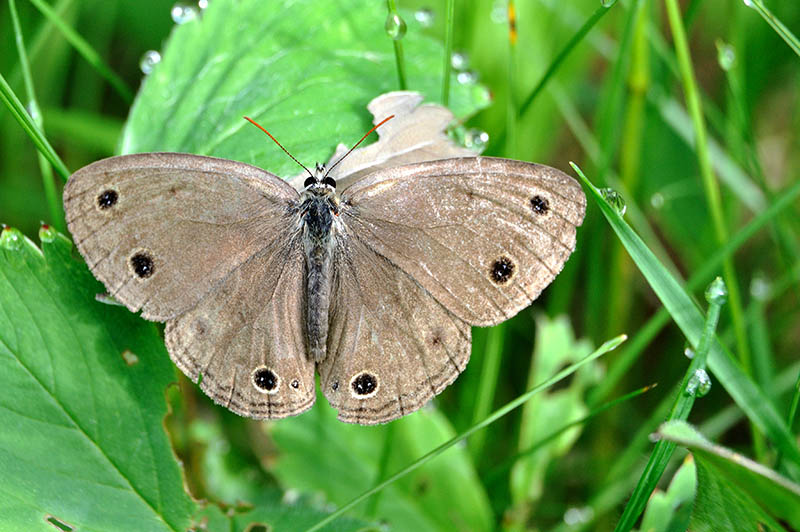
| Scientific name: | Megisto cymela |
| Identifying Characteristics: | Smokey brown wings with large eye spots and darker brown lines on the wings border |
The Little Wood Satyr can be found all over Massachusetts. It is primarily a species of deciduous woodland edges, and it is most commonly seen where countryside and forests meet, flying within the shade of bordering shrubs and trees.
21. Great Spangled Fritillary
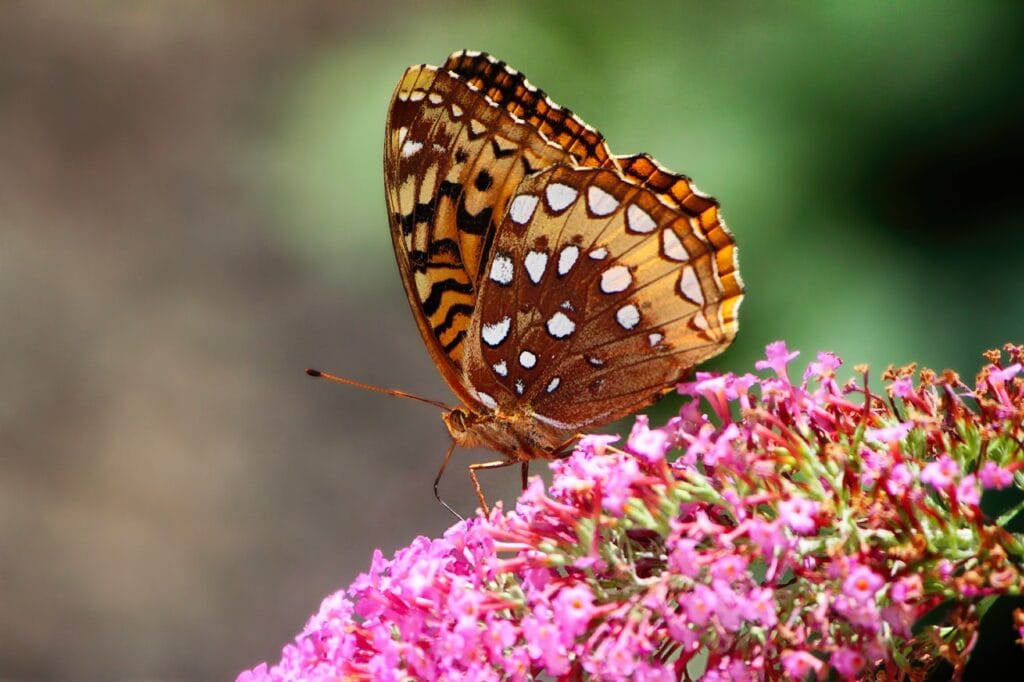
| Scientific name: | Speyeria cybele |
| Identifying Characteristics: | Orange with black lines and dots that form a web-like pattern on their wings. The undersides of their wings have silvery white dots outlined in black |
Throughout much of the state, the Great Spangled Fritillary is common but not abundant. Meadows are among the best places in the state to see Great Spangled Fritillary butterflies; when they’re searching for milkweed, thistle, Joe-Pye-weed, red clover, and alfalfa, they will frequently visit well-maintained gardens.
22. Gray Hairstreak

| Scientific name: | Strymon melinus |
| Identifying Characteristics: | Gray underwings with black, white, and orange bands close to the edge |
Gray hairstreak butterflies are attracted to many species of plants, and in Massachusetts, they enjoy the hound’s tongue. Gray Hairstreaks are one of only a few butterflies in Massachusetts with hair-like thin, long wing tails. They are a defense mechanism that keeps predators away from the butterfly’s body.
Gray Hairstreaks give themselves time to escape by imitating a head with antennae and using its eyespots as a diversion. They can be found in open areas such as roadside ditches, unused meadows, and rural pastures.
23. Common Wood Nymph
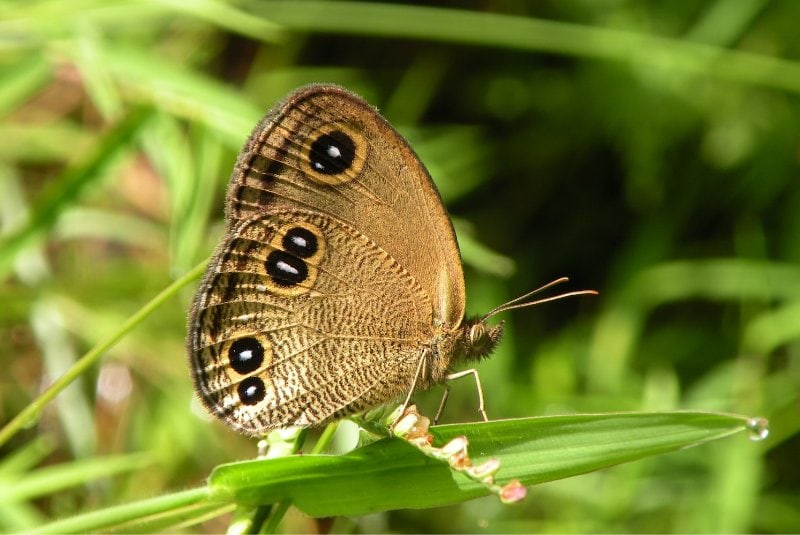
| Scientific name: | Cercyonis pegala |
| Identifying Characteristics: | Shades of brown with dark eyespots |
The Common Wood-Nymph is a well-known brown butterfly with two eyespots on the forewings that can be found in a variety of habitats, such as open forests and meadows. Look for this species in late summer and early fall when it is most active.
24. Azure

| Scientific name: | Celastrina ladon |
| Identifying Characteristics: | Smokey gray/blue wings with gray stripes and spots |
Azure butterflies are common and abundant in Massachusetts but are among the state’s shortest-lived butterflies. They live in open forest areas, forest edges, grasslands, and hiking trails. From the first warm days of April until the beginning of September, it flies almost continuously.
25. Eastern Pine Elfin

| Scientific name: | Callophrys niphon |
| Identifying Characteristics: | Brown/orange wings. Below the hindwing is boldly patterned with many offset blackish bands crossing the veins |
The Eastern Pine Elfin is found from early May to mid-June and is fairly common throughout the state. These butterflies also appear later in the season because they are mostly seen at high altitudes. As its name suggests, it can be found in open pine and pine-oak woods.
26. Wild indigo Duskywing

| Scientific name: | Erynnis baptisiae |
| Identifying Characteristics: | Mottled brown with black veins and spots |
The name of this brown butterfly comes from the indigo plants that it feeds on. Every season, a couple of broods are seen across the state. They can be found in areas that are dry, open, rocky, or sandy, but powerline corridors are currently the most common habitat. Local extinction of small colonies is common due to the changing nature of the habitat.
27. Eastern Tiger Swallowtail
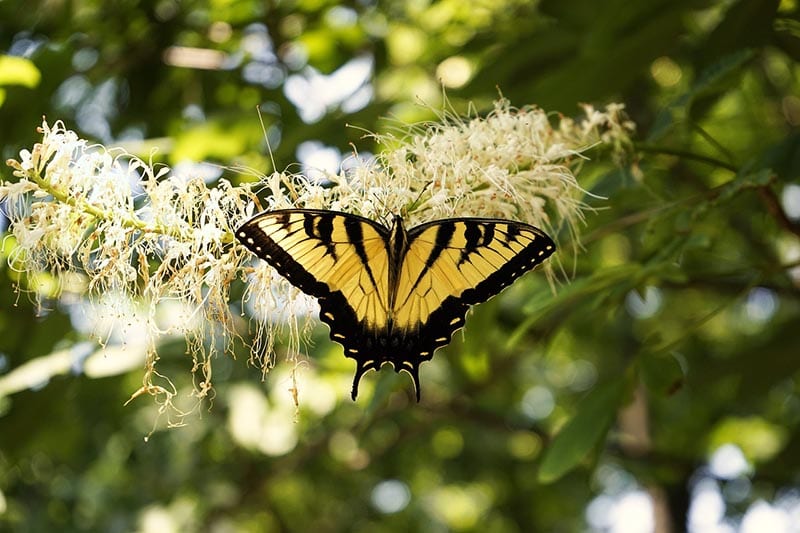
| Scientific name: | Pamilio glaucus |
| Identifying Characteristics: | Males are always a bright yellow color with black stripes and borders. Females are slightly darker yellow with more prominent black markings, and some are almost entirely black, with specks of light blue on the lower wings |
The Eastern Tiger Swallowtail is one of the most stunning species in Massachusetts, which makes them easy to identify. They are solitary butterflies, so you are likely to spot one flying alone. They are also easy to attract to your yard by inviting them with flowers.
28. Orange Sulfur

| Scientific name: | Colias eurytheme |
| Identifying Characteristics: | Bright yellow wings with black spots and black borders |
The Orange Sulphur is abundant and widespread in Massachusetts and can be seen during spring and summer in urban areas. It can be identified easily by its flight pattern. They fly in an erratic, twitchy way and usually stay low to the ground.
29. Common Ringlet

| Scientific name: | Coenonympha california |
| Identifying Characteristics: | Almost completely white with orange and tan markings across its wings |
Although the Common Ringlet is almost entirely white, its orange markings make it one of the brightest butterflies in Massachusetts. This butterfly is mostly seen just above the ground in sunny places and is only known to fly short distances. Each year, up to three broods of Common Ringlet butterflies with minor color differences are observed.
30. Northern Broken-Dash

| Scientific name: | Polites egeremet |
| Identifying Characteristics: | Dark brown with sections of yellow and white bands on its wings |
These small butterflies are very common throughout the state. Many butterflies in the Northern Broken-Dash species live near woodlands, farmlands, or roadside grasslands and can be seen flying just above the ground.
Conclusion
Many species of butterflies can be found in Massachusetts. Several of them enjoy visiting well-cultivated gardens, so if you want to attract them to your yard, get planting! While they are widespread, and some of them are approachable, it’s best to admire them and avoid trying to pick them up, as their fragile wings can be damaged easily.
Featured Image Credit: Magnus Binnerstam, Shutterstock
Contents






